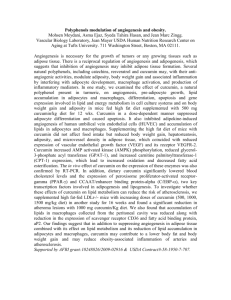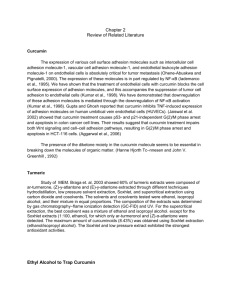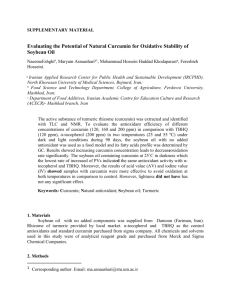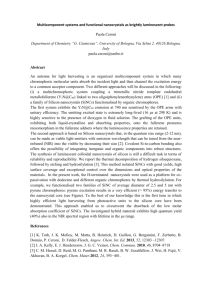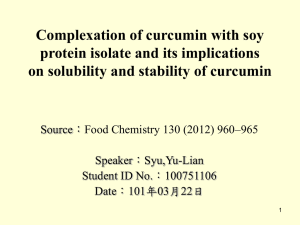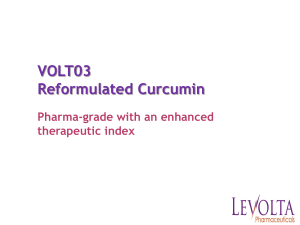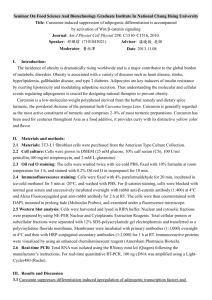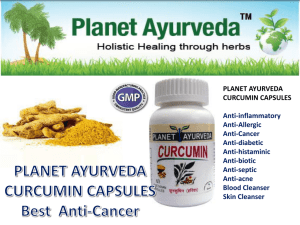Date - 國立中興大學食品暨應用生物科技學系
advertisement
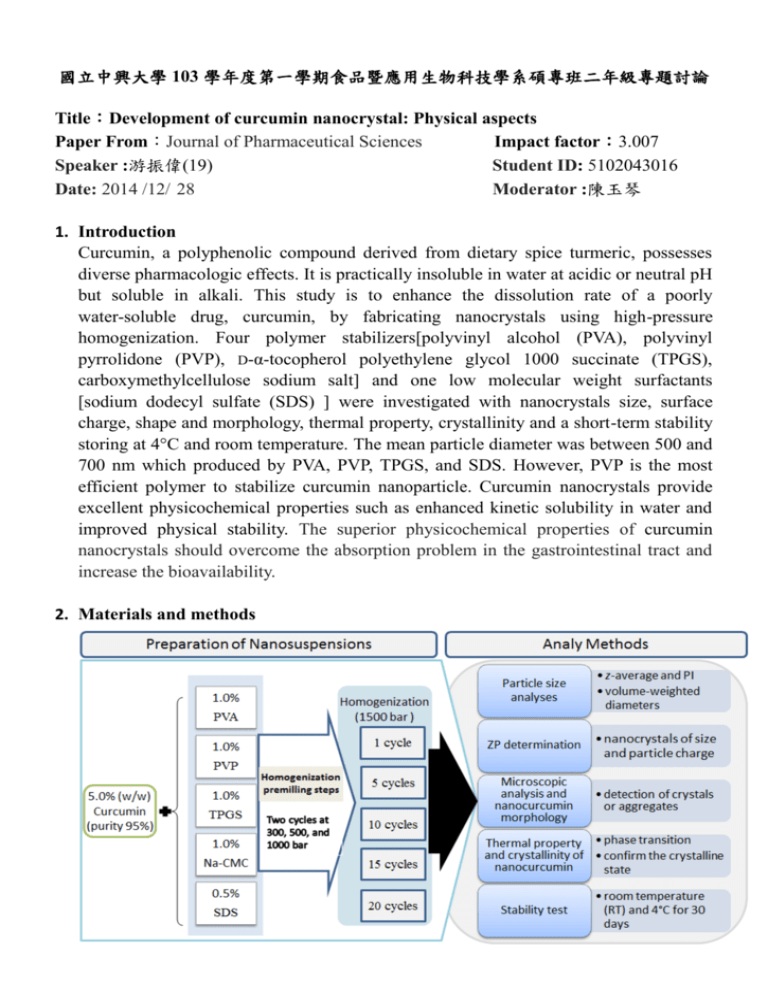
國立中興大學 103 學年度第一學期食品暨應用生物科技學系碩專班二年級專題討論 Title:Development of curcumin nanocrystal: Physical aspects Paper From:Journal of Pharmaceutical Sciences Impact factor:3.007 Speaker :游振偉(19) Student ID: 5102043016 Date: 2014 /12/ 28 Moderator :陳玉琴 1. Introduction Curcumin, a polyphenolic compound derived from dietary spice turmeric, possesses diverse pharmacologic effects. It is practically insoluble in water at acidic or neutral pH but soluble in alkali. This study is to enhance the dissolution rate of a poorly water-soluble drug, curcumin, by fabricating nanocrystals using high-pressure homogenization. Four polymer stabilizers[polyvinyl alcohol (PVA), polyvinyl pyrrolidone (PVP), D-α-tocopherol polyethylene glycol 1000 succinate (TPGS), carboxymethylcellulose sodium salt] and one low molecular weight surfactants [sodium dodecyl sulfate (SDS) ] were investigated with nanocrystals size, surface charge, shape and morphology, thermal property, crystallinity and a short-term stability storing at 4°C and room temperature. The mean particle diameter was between 500 and 700 nm which produced by PVA, PVP, TPGS, and SDS. However, PVP is the most efficient polymer to stabilize curcumin nanoparticle. Curcumin nanocrystals provide excellent physicochemical properties such as enhanced kinetic solubility in water and improved physical stability. The superior physicochemical properties of curcumin nanocrystals should overcome the absorption problem in the gastrointestinal tract and increase the bioavailability. 2. Materials and methods 3. Results and discussion 3.1 After homogenization 20 cycles, the size increased in the order of: TPGS<SDS<PVP < PVA <Na-CMC. SDS as well dispersing, fast diffusing low-molecular weight surfactant should reveal the best performance in the nanoparticle production. 3.2 The magnitude of the zeta potential gives an indication of the potential stability of the colloidal system. SDS-stabilized and Na-CMC-stabilized nanosuspension has the highest ZP value. 3.3 Particle size of the PVP nanoparticles was drastically decreased from microscale to nanoscale (±400 nm). 3.4 DSC and X-ray diffraction were used to study the crystalline state of Curcumin nanocrystals. Homogenization process did not change the crystallinity of curcumin. 3.5 The nanosuspensions stabilized with PVA, PVP, and TPGS are stable over period of 30 days at both storage conditions. SDS-stabilized and Na-CMC-stabilized leading to particle aggregation. 4. Conclusion: PVA, PVP, TPGS, and SDS were succesfully to produced nanocrystals of curcumin with the particle size in the range of 500–700 nm. Na-CMC which indicating presence of aggregates is not sufficient to stabilize aqueous curcumin nanosuspensions. PVA, PVP, and TPGS showed similar performance in preserving the nanosuspension stability. Based on these physicochemical studies, curcumin nanocrystals provide excellent physicochemical properties such as increased dissolution velocity, enhanced kinetic solubility in water and improved physical stability. 5. References 5.1 Kinetic solubility and dissolution velocity of rutin nanocrystals. Mauludin R, Müller RH, Keck CM. 2009. 5.2 Lipid nanocarriers for dermal delivery of lutein: Preparation, characterization, stability and performance. Mitri, R. Shegokar, S. Gohla, C. Anselmi, R.H. Müller 2011
